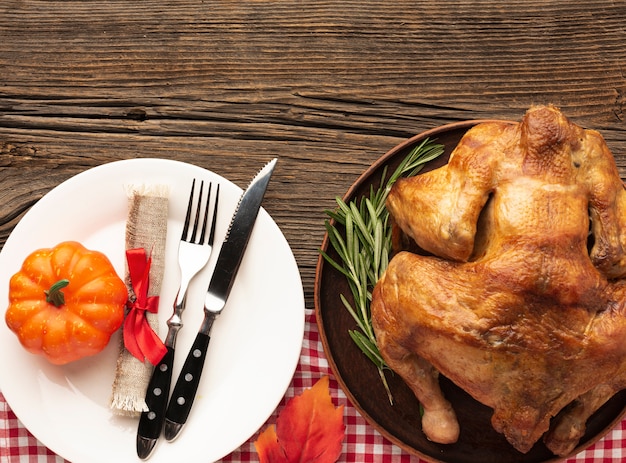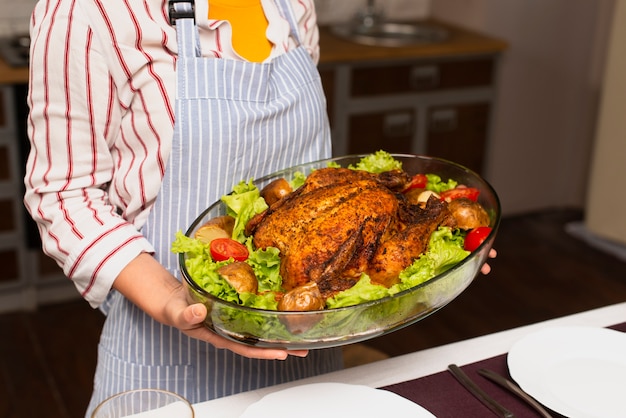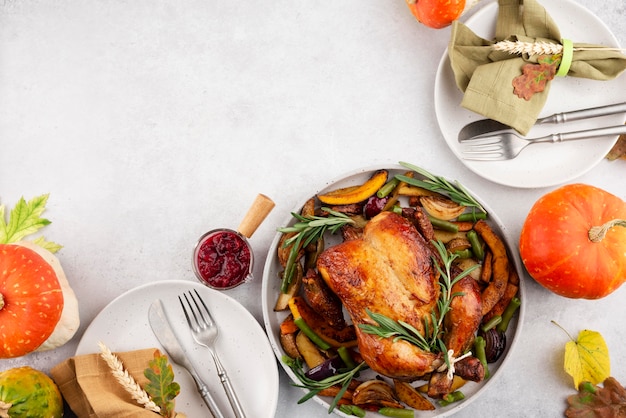The aroma of a perfectly roasted turkey is enough to make any gathering feel festive. But getting that golden-brown bird, juicy and flavorful, requires more than just throwing it in the oven and hoping for the best. I've learned that over the years, and I'm here to share my hard-earned turkey cooking wisdom with you.
This guide isn't just about the cooking time; it's about understanding the science behind roasting a turkey, tackling different sizes and weights, and even prepping the bird to ensure it cooks evenly. It's about achieving that elusive "perfectly cooked turkey" status, leaving you with enough delicious leftovers to satisfy everyone. So, let's get started!
(Part 1) The Turkey Basics: From Fresh to Frozen

Before you even think about the oven, you need to get acquainted with your turkey. What kind are you working with? Is it a fresh or frozen bird? A whole turkey or a turkey breast? Understanding these differences is crucial, as each type presents its own set of cooking quirks.
Fresh vs. frozen turkeys
Fresh Turkeys: These are the ones you find in the refrigerated section of your supermarket. They're generally easier to handle than frozen turkeys because you don't have to defrost them. However, fresh turkeys are usually only available during the peak holiday season, so they might not be an option if you're planning ahead.
Frozen Turkeys: You'll find these in the freezer aisle, and they're a great choice if you need a turkey well in advance. The key is to give the bird plenty of time to thaw in the refrigerator. You can also thaw a turkey in cold water, but I find the refrigerator method is less messy. Just make sure to use a clean container and change the water every 30 minutes or so.
Whole Turkey vs. Turkey Breast
Whole Turkeys: These are the classic option for a grand occasion. They come in a range of sizes, perfect for a large crowd or a big celebration. However, they do take longer to cook than turkey breasts.
Turkey Breasts: These are a fantastic choice for smaller gatherings or if you prefer a more manageable size. They cook much faster than whole turkeys, but they can be a bit trickier to carve.
(Part 2) Size Matters: Weighing Your Turkey

Alright, now that you've chosen your turkey, you need to determine its weight. This is crucial for figuring out how long you'll need to cook it. Don't just eyeball it; get out the scales and weigh the bird accurately! It's the only way to ensure a perfectly cooked turkey.
(Part 3) The Science of Turkey Cooking: Mastering internal temperature

Roasting a turkey is a science, and understanding the internal temperature is key to achieving that perfect result. While cooking time is a factor, it's the internal temperature that truly dictates when the bird is done.
The Importance of 165°F (74°C)
A turkey is considered cooked through when its internal temperature reaches 165°F (74°C) in the thickest part of the thigh. This ensures the meat is safe to eat and cooked to a delicious, juicy perfection.
Understanding Oven Temperatures
Oven temperatures are equally important. Most recipes recommend cooking turkeys at 325°F (163°C). This standard temperature allows the turkey to cook evenly and develop a beautiful golden-brown crust.
(Part 4) Turkey Prep: Setting the Stage for Success
Before you pop your turkey into the oven, there's some essential prep work to be done. It might seem like extra steps, but these techniques ensure an incredibly flavorful and moist turkey.
The Rinse and Pat Dry Routine
Start by rinsing the turkey inside and out with cold water. Make sure to pat it dry thoroughly with paper towels. This removes any excess moisture that could lead to steam build-up and soggy skin.
Brining: A Flavor Boost and Moistening Technique
Brining is a game-changer for turkey lovers. It involves soaking the turkey in a salt-water solution for several hours. The salt draws moisture into the meat, resulting in a tender and flavorful bird that's practically bursting with juicy goodness.
Butter and Herb Treatment
I love to rub a mixture of butter and herbs under the skin of the turkey. This adds a delicious flavor profile and helps keep the meat moist during cooking.
Stuffing: The Great Debate
Now, here comes the big question: to stuff or not to stuff? I'm a bit old-fashioned and prefer to stuff my turkey. However, I'm also a firm believer in food safety.
If you choose to stuff your turkey, ensure it's cooked to an internal temperature of 165°F (74°C) in the stuffing. This is crucial to prevent bacterial growth and ensure everyone enjoys a safe meal. Otherwise, it's best to cook your stuffing separately.
The Basting Debate: To Baste or Not to Baste?
Some people swear by basting, while others think it's unnecessary. It's truly a matter of personal preference. Basting helps keep the turkey moist, but it can also make the skin soggy. I usually give it a quick baste midway through cooking, just to ensure it stays juicy.
(Part 5) Turkey Cooking Time: The Big Reveal
Alright, your turkey is prepped, and you're ready to go! Let's talk about how to cook it to perfection:
The Oven Temperature Is Key
Make sure your oven is preheated to 325°F (163°C). This ensures the turkey cooks evenly and develops that lovely golden-brown crust we all crave.
The Initial Roast
Place the turkey in a roasting pan and roast for about 30 minutes per pound. Avoid opening the oven door too often during the initial roasting, as it can cause the temperature to drop and slow down cooking time.
The Thermometer Check
After about 30 minutes per pound, check the internal temperature in the thickest part of the thigh, avoiding the bone. If the temperature isn't 165°F (74°C), continue cooking for another 15-30 minutes and check again.
The Resting Period
Once the turkey reaches 165°F (74°C), it's time to let it rest! This crucial step allows the juices to redistribute throughout the meat, resulting in a tender and flavorful bird. Cover the turkey loosely with foil and let it rest for at least 20 minutes.
(Part 6) Turkey Cooking Time: Avoiding the Common Pitfalls
Now, let's talk about some common turkey cooking mistakes and how to avoid them:
The Overcooked Turkey: Dry as a Bone
You know the feeling; you cut into the turkey, and it's so dry it's practically crumbly. This usually happens when the turkey is cooked for too long. To avoid this, make sure to check the internal temperature regularly and remove it from the oven when it reaches 165°F (74°C).
The Undercooked Turkey: A Food Safety Risk
On the other side of the spectrum, you could end up with an undercooked turkey. This is a major food safety concern, as it could lead to food poisoning. Ensure the internal temperature reaches 165°F (74°C) in the thickest part of the thigh, and don't be afraid to cook it a little longer if needed.
The Unevenly Cooked Turkey: A Sign of Trouble
This usually happens when the turkey isn't positioned properly in the oven or when the oven temperature isn't even. To avoid this, make sure to place the turkey in the center of the oven and rotate it halfway through cooking.
The Soggy Skin: A Disappointing Finish
A nice crispy skin is essential for a delicious turkey. However, if the turkey is basted too often or if it's cooked at a low temperature, the skin can become soggy. To avoid this, try limiting basting and cooking at a higher temperature for the last 30 minutes of cooking.
(Part 7) Turkey Cooking Time: Beyond the Basics
Now, let's venture beyond the traditional oven-roasted turkey and explore some alternative cooking methods:
cooking a turkey in a slow cooker
You might be surprised to learn that you can actually cook a turkey in a slow cooker! It's a great option for a moist and flavorful turkey, especially if you're looking for a hands-off approach. You'll need a large slow cooker, and you'll need to cook the turkey for about 6-8 hours on low.
Cooking a Turkey in a Roasting Bag
Another alternative is using a roasting bag. This helps to trap moisture and ensures a juicy turkey. However, it can make the skin a bit soggy, so you might need to remove the bag for the last 30 minutes of cooking to crisp up the skin.
Cooking a Turkey in a pressure cooker
If you're short on time, consider using a pressure cooker. It can cook a turkey in just a fraction of the time, but the result might not be as traditional.
(Part 8) turkey leftovers: A Delicious Dilemma
You've cooked the perfect turkey, and now you have a mountain of leftovers! Don't despair; this is a good thing. Leftover turkey is perfect for sandwiches, salads, soups, and even turkey pot pie.
Storing Leftovers: Keeping It Safe
It's crucial to store leftover turkey correctly to prevent foodborne illness. Refrigerate the leftovers within two hours of cooking and use them within 3-4 days. You can also freeze turkey leftovers for up to 2-3 months.
(Part 9) Turkey Cooking Time: FAQs
1. What is the best way to thaw a frozen turkey?
The safest and most recommended way to thaw a frozen turkey is in the refrigerator. Allow approximately 24 hours for every 5 pounds of turkey to thaw completely.
2. Can I stuff the turkey the day before?
It's not recommended to stuff the turkey the day before, as it can encourage bacterial growth. Stuff the turkey just before roasting for the safest approach.
3. How do I know if the turkey is cooked through?
Use a meat thermometer to check the internal temperature in the thickest part of the thigh, avoiding the bone. The turkey is done when the temperature reaches 165°F (74°C).
4. What should I do if the turkey is undercooked?
If the turkey is undercooked, return it to the oven and cook it for an additional 15-30 minutes, checking the temperature every 15 minutes until it reaches 165°F (74°C).
5. What can I do with leftover turkey?
The possibilities are endless! Leftover turkey can be used for sandwiches, salads, soups, turkey pot pie, and many other delicious dishes.
(Part 10) Conclusion
There you have it, my comprehensive guide to cooking the perfect turkey! Remember, it's not just about the time; it's about understanding the bird, preparing it properly, and using a thermometer to ensure it's cooked to perfection.
Now, go forth and conquer your next turkey feast. And remember, if you have any questions, don't hesitate to ask. Happy cooking!
Everyone is watching

Prime Rib Roast Cooking Time Chart: Per Pound Guide
Cooking TipsPrime rib roast. Just the name conjures images of lavish dinners, crackling fires, and hearty laughter. It’s ...

How Long to Bake Potatoes in the Oven (Perfect Every Time)
Cooking TipsBaked potatoes are a staple in my kitchen. They're incredibly versatile, delicious, and surprisingly easy to m...

Perfect Rice Every Time: The Ultimate Guide to Cooking Rice
Cooking TipsAs a self-proclaimed foodie, I've always been a bit obsessed with rice. It's the foundation of countless cuisi...

The Ultimate Guide to Cooking Asparagus: Tips, Techniques, and Recipes
Cooking TipsAsparagus. The mere mention of this spring delicacy conjures up images of vibrant green spears, crisp and burs...

Ultimate Guide to Cooking the Perfect Thanksgiving Turkey
Cooking TipsThanksgiving. Just the word conjures up images of overflowing tables laden with delicious food, the scent of r...
